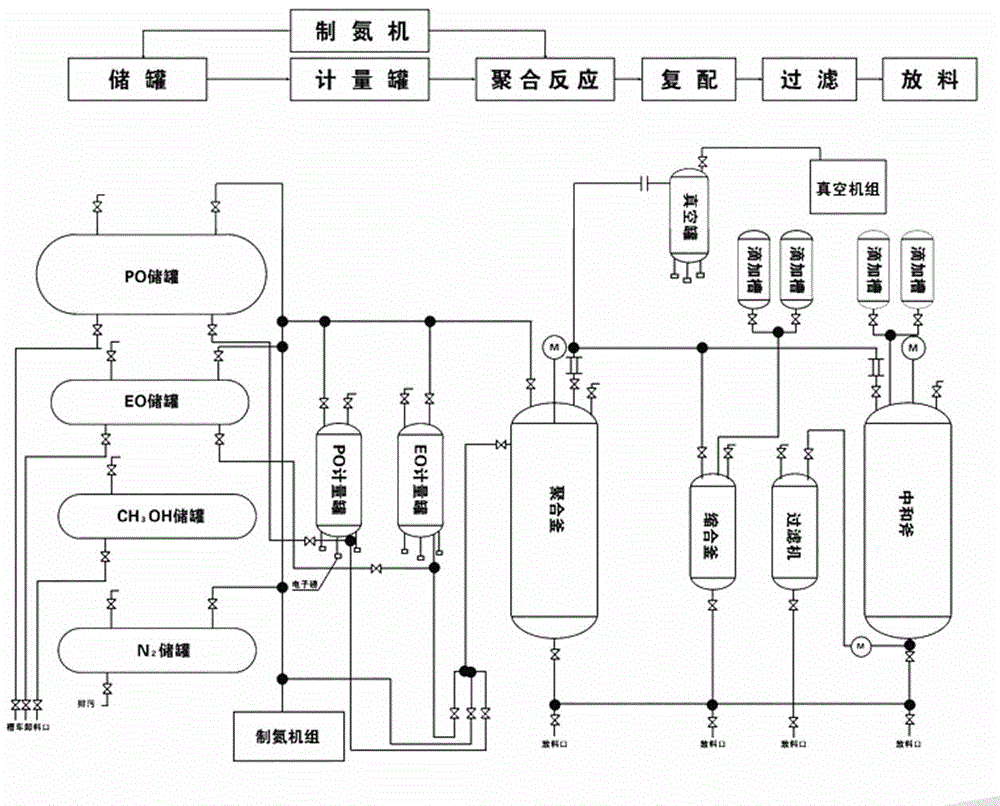A kind of preparation method of novel polyol demulsifier
An alcohol demulsifier and multi-component technology, applied in the field of preparation of a new type of polyol demulsifier, can solve the problems of difficulty in surface oil and water treatment, complex properties of produced fluid, and polyol demulsifier has not yet been seen, and achieves fast oil-water separation speed, The effect of low oil content in water
- Summary
- Abstract
- Description
- Claims
- Application Information
AI Technical Summary
Problems solved by technology
Method used
Image
Examples
Embodiment 1
[0021] first step
[0022] Add 300kg of neopentyl glycol and 6kg of KOH catalyst into the polyether reactor, start stirring, heat the material to 100°C-110°C, vacuum dehydrate (about 10min), and when no water is distilled out, close the vacuum valve to make The pressure in the kettle is close to -0.08~-0.10Mpa; then slowly feed 2700kg of propylene oxide to control the reaction pressure ≤0.4Mpa, and keep the reaction temperature at 130~140℃; Falling down again, the reaction is finished, and the material is discharged for later use.
[0023] second step
[0024] Take 300kg of the above materials and 9kg of KOH catalyst into the polyether reactor, start stirring, heat the materials to 100°C-110°C, vacuum dehydrate (about 10min), and when no water is distilled, close the vacuum valve to make the kettle The pressure is close to -0.08~-0.10Mpa; then slowly feed 2700kg propylene oxide and 1285kg ethylene oxide in sequence, control the reaction pressure ≤0.4Mpa, and keep the reactio...
Embodiment 2
[0027] first step
[0028] Add 250kg of neopentyl glycol and 6kg of KOH catalyst into the polyether reactor, start stirring, heat the material to 100°C-110°C, vacuum dehydrate (about 20min), and when no water is distilled out, close the vacuum valve to make The pressure in the kettle is close to -0.08~-0.10Mpa; then slowly feed 2500kg of propylene oxide to control the reaction pressure ≤0.4Mpa, and keep the reaction temperature at 130~140℃; Falling down again, the reaction is finished, and the material is discharged for later use.
[0029] second step
[0030] Add 220kg of the above material and 9kg of KOH catalyst into the polyether reactor, start stirring, heat the material to 100°C-110°C, vacuum dehydrate (about 20min), and when no water is distilled, close the vacuum valve to make the kettle The pressure is close to -0.08~-0.10Mpa; then slowly feed 2780kg propylene oxide and 1285kg ethylene oxide in sequence, control the reaction pressure ≤ 0.4Mpa, and keep the reaction ...
Embodiment 3
[0033] first step
[0034] Add 300kg of neopentyl glycol and 6kg of KOH catalyst into the polyether reactor, start stirring, heat the material to 100°C-110°C, vacuum dehydrate (about 10min), and when no water is distilled out, close the vacuum valve to make The pressure in the kettle is close to -0.08~-0.10Mpa; then slowly feed 2700kg of propylene oxide to control the reaction pressure ≤0.4Mpa, and keep the reaction temperature at 130~140℃; Falling down again, the reaction is finished, and the material is discharged for later use.
[0035] second step
[0036] Add 300kg of the above materials and 9kg of KOH catalyst into the polyether reaction kettle, start stirring, heat the materials to 100°C~110°C, vacuum dehydrate (about 10min), and when no water is distilled, close the vacuum valve to make the kettle The pressure is close to -0.08~-0.10Mpa; then slowly feed 2100kg propylene oxide and 1255kg ethylene oxide in sequence, control the reaction pressure ≤0.4Mpa, and keep the ...
PUM
| Property | Measurement | Unit |
|---|---|---|
| dehydration rate | aaaaa | aaaaa |
| dehydration rate | aaaaa | aaaaa |
| dehydration rate | aaaaa | aaaaa |
Abstract
Description
Claims
Application Information
 Login to View More
Login to View More - R&D
- Intellectual Property
- Life Sciences
- Materials
- Tech Scout
- Unparalleled Data Quality
- Higher Quality Content
- 60% Fewer Hallucinations
Browse by: Latest US Patents, China's latest patents, Technical Efficacy Thesaurus, Application Domain, Technology Topic, Popular Technical Reports.
© 2025 PatSnap. All rights reserved.Legal|Privacy policy|Modern Slavery Act Transparency Statement|Sitemap|About US| Contact US: help@patsnap.com

